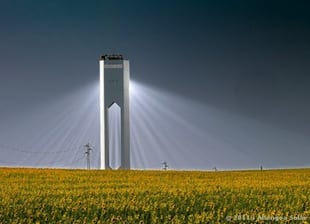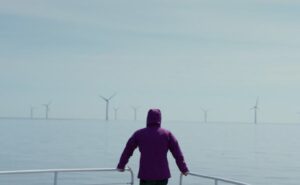 Late last week, the California Energy Commission approved the Palen Solar Power Project, after scaling down the concentrated solar project from two 750-foot, 250-megawatt towers to one tower on a smaller piece of real estate. The final decision on the controversial solar project will be made at the end of October.
Late last week, the California Energy Commission approved the Palen Solar Power Project, after scaling down the concentrated solar project from two 750-foot, 250-megawatt towers to one tower on a smaller piece of real estate. The final decision on the controversial solar project will be made at the end of October.
The Palen project has a long and contentious history.
- In 2009, the 500-megawatt concentrated solar power (CSP) facility was planned, based on solar parabolic trough technology.
- In 2012, the project was transferred from bankrupt Solar Millennium to BrightSource Energy. BrightSource is the venture-funded startup that built the Ivanpah CSP plant, but which failed to make it through the IPO window in 2012.
- BrightSource formed a joint venture with Abengoa Solar to develop the site using BrightSource’s solar power tower technology instead of trough technology, albeit without thermal storage capability. Spain’s Abengoa Solar has already built 743 megawatts of operating CSP tower and trough projects.
- Last week, the committee released a revised Presiding Member’s Proposed Decision on the project.
BrightSource has seen its CSP pipeline diminish as a result of the regulatory process over the past few years.
As reported in GTM, in 2012, the California Public Utilities Commission approved revised power-purchase agreements between BrightSource Energy and Southern California Edison for electricity generated by one 250-megawatt unit of BSE’s proposed 500-megawatt Rio Mesa solar power tower project and one 250-megawatt unit of its proposed Sonoran West tower project. The CPUC also rejected three proposed BSE-SCE PPAs. The revised Sonoran West PPA provided for incorporation of “a few hours” of storage capacity with BSE’s steam-heated molten salts storage system.
Abengoa will handle the engineering, procurement and construction for the Palen project. After the project’s optimistically targeted 2016 completion (which would be in time to qualify Palen for the 30 percent federal Investment Tax Credit), Abengoa will also oversee operations and maintenance.
Abengoa noted at the time, “The fact that we are joining BrightSource in this project doesn’t mean we are abandoning trough technology.”
Permitting, which is always challenging in California, might have been a bit easier because Palen is in a Department of the Interior Solar Energy Zone in Riverside County, near California’s Joshua Tree National Monument.
Wildlife and environmental concerns
It would be premature to buy suntan lotion for your Palen suntan just yet. Now that the California Energy Commission’s recommendation has been made, there will be a 30-day public comment period. And environmentalists and bird-lovers everywhere are certainly going to comment. The CEC’s preliminary decision acknowledged that the project will cause “significant unmitigated impacts to biological, cultural, and visual resources,” but suggests that the benefits outweigh those environmental issues. CEC staff have reported that Palen will pose a greater risk to bird life than BrightSource’s Ivanpah project.
BrightSource has spent millions of dollars studying the sex life and respiratory conditions of the desert tortoise, a threatened resident of the Ivanpah area.
The Desert Sun‘s Sammy Roth reports, “Palen’s approval is sure to anger environmental and Native American groups, which have vigorously opposed the project,” adding, “Seth Shteir, California desert senior field representative for the National Parks Conservation Association, said in an email that Palen’s approval ‘is as dangerous as it is disheartening for wildlife, scenic vistas and our responsible renewable energy future.’ He said that the project will be located directly underneath the Pacific Flyway, a migratory bird pathway a few miles from Joshua Tree National Park, and that it will kill eagles, raptors and songbirds. Shteir added, ‘The Palen project would also mar Joshua Tree National Park’s pristine undeveloped vistas and cause light pollution that would harm the park’s clear, dark night skies.’”
Roth interviewed Donna Charpied, who lives near the 550-megawatt Desert Sunlight solar project outside of Desert Center. She said that between Palen’s approval and successful efforts to develop other large-scale energy projects in the desert, “There’s just one conclusion I can come to: local, state, and federal governments hate the desert.” She called Palen’s approval “unconscionable and despicable.”
CSP in the U.S.
The U.S. installed 517 megawatts of CSP in Q1 2014, more than the 410 megawatts installed in all of 2013, according to GTM Research.
Recently completed CSP projects include Abengoa’s 280-megawatt Solana parabolic trough project in Arizona with six hours of storage, NextEra’s 250-megawatt Genesis solar project, and BrightSource Energy’s 370-megawatt Ivanpah solar power tower in California’s Mojave Desert. GTM Research says “the next notable project slated for completion is SolarReserve’s 110-megawatt Crescent Dunes plant, which entered the commissioning phase in February 2014.” Crescent Dunes is a solar power tower outside Tonopah, Nevada, with ten hours of molten salt storage and a PPA from NV Energy.
Can CSP compete with PV?
As GTM Research reports, “Declines in PV module costs have undercut trough technology and put it at a significant cost disadvantage. Since the beginning of 2013, CSP projects totaling 1 gigawatt have been suspended, and an additional 305 megawatts have been delayed.”
Firms such as Areva, Siemens, Sopogy and Infinia have exited the CSP business. Abengoa, the Spanish-owned CSP developer, still maintains that declining capital costs and improved efficiency levels will make CSP competitive with combined-cycle gas turbines on cost, efficiency and utility by 2020.
Other CSP firms include eSolar, which has attempted a pivot to enhanced oil recovery (see GlassPoint), along with BrightSource. Unfortunately, the tower-based architecture employed by BrightSource and eSolar might be the wrong design for EOR.
GTM Research solar analyst Cory Honeyman said in an email, “The preliminary approval of Palen Solar is a major win for BrightSource and NRG after a long, extensive regulatory proceeding administered by the CEC. However, the outlook for CSP remains uncertain, given the technology’s limited cost reductions and the early-stage permitting challenges seen over the past few years. Meanwhile, utility-scale PV projects have pushed the boundaries of competitive pricing for solar, with contracts signed between $50 per megawatt-hour and $70 per megawatt-hour.”
Recent proposed bid prices for CSP projects are more than three times the price of photovoltaics.
Honeyman adds, “With the federal ITC scheduled to drop off at the end of 2016, CSP faces the added challenge of landing new contracts in California with start dates several years down the line. Taking all of that into consideration, the outlook for CSP will depend on on commercializing innovations that reduce hardware costs and yield ancillary benefits, including CSP paired with storage.”
Source: Greentech Media. Reproduced with permission.








